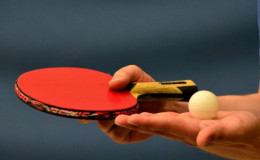
- A sport featuring two players (singles) or four players (doubles).
- Play with lightweight, hollow ball back and forth using table tennis rackets.
- It is played on a hard table divided by a net.
- Table tennis, also known as ping-pong,
- It is an Olympic sport (since 1988)
Table tennis ball:
- The international rules specify that the game is played with a light 2.7 gram, 40 mm diameter ball.
- The ball shall bounce up 24–26 cm when dropped from a height of 30.5 cm on to a standard steel block.
- The 40 mm ball was introduced after the 2000 Olympic Games.
- A 40 mm table tennis ball is slower and spins less than the original 38 mm (1.5 inch) one
- The ball is made of a high-bouncing air-filled celluloid or similar plastics material, colored white or orange, with a matte finish.
- The choice of the ball color is made according to the table color and its surroundings.
Table tennis racket:
- The official ITTF term is "racket" though "bat" is common in Britain, and "paddle" in the U.S.
- The average size of the blade is about 6.5 inches (16.5 cm) long and 6 inches (15 cm) wide.
- There are no official restrictions on the shape or size of the blade itself, these dimensions is optimal for most play styles.
- There are no restrictions on a blade's composition except that it be at least 85% natural wood.
- Players are equipped with a laminated wooden racket covered with rubber on one or two sides depending on the grip of the player.
- Table tennis regulations allow different surfaces on each side of the racket.
- Various types of surfaces provide various levels of spin or speed, and in some cases they nullify spin.
- Current rules state that, unless damaged in play, the racket cannot be exchanged for another racket at any time during a match
Table tennis Board:
- The table is 2.74 m (9 ft) long, 1.525 m (5 ft) wide, and 76 cm (30 inch) high with a Masonite (a type of hardboard) or similarly manufactured timber, layered with a smooth, low-friction coating.
- The table or playing surface is divided into two halves by a 15.25 cm (6 inch) high net.
- An ITTF approved table surface must be in a green or blue color.
Basic Rules and regulations:
- A game of table tennis is now played up to 11 points with 2 serves. (until 2001 it was 21 points with 5 serves)
- The winner is the player or pair who first scores 11 points, unless both players and pairs score 10 points (called deuce).
- Then a game will be won by the first player or pair to gain a two point lead.
- Before you start a game, you'll need to decide who's going to serve first.
- The official rules of table tennis say that it is decided by lot, usually by tossing a coin or disc having two distinct sides. (However, the most common method is to hide the ball in one hand, put both your hands under the table)
- Although the winner of this usually serves first, he actually has three choices.
* elect to serve first or
* make his opponent serve first or
* decide which end of the table he prefers to play at first
- The server must stand behind the end of the table to serve.
- The basic serve involves holding the ball in the palm of your non-playing hand and throwing it upwards.
- As the ball is falling, you must hit it with your racket, so that it bounces once on your side of the table, and at least once on your opponent's side of the table.
- If your opponent allows the ball to bounce more than once on their side of the table, they will lose the point.
- The ball may bounce anywhere on both sides of the table and unlike tennis, you don't have to serve to one part of the table - unless you're playing doubles.
- If the ball touches the net and still bounces on your opponent's side of the table, the service must be replayed.
- However, if the ball touches the net and does not bounce on your opponent's side of the table, the server loses the point.
- Service continues to alternate between opponents until one player scores 11 points, unless both players and pairs score 10 points (called deuce).
- If both players reach 10 points, then service alternates after each point, until one player gains a two point lead.
For doubles:
- While playing table tennis doubles, each player still has two serves and the service still alternates every two points between sides, but it also alternates between players on the same team.
- At the end of every two points, the receiving player becomes the server, and the partner of the serving player becomes the receiver.
- The service itself is exactly the same as in singles except that, rather than the ball bouncing anywhere on the table, it must bounce only on the right half portion of the table for both the server and the receiver.
- The rules of table tennis state that a match is the best of any odd number of games - usually 3, 5 or 7 games.
Table tennis governing bodies:
- The International table Tennis Federation (IITF)- in 1926.
- The ITTF was founded in 1926, the nine founding members being Austria, Czechoslovakia, Denmark, England, Germany, Hungary, India, Sweden and Wales.
- The first international tournament was held in January 1926 in Berlin while the first World Table Tennis Championships was held in December 1926 in London.
- The role of the ITTF includes overseeing rules and regulations and seeking technological improvement for the sport of table tennis.
- The ITTF is responsible for the organization of numerous international competitions, including the Table Tennis World Table Tennis Championships that has continued since 1926.
The ITTF recognizes six continental federations.
- Africa Table Tennis Federation (ATTF)
- Asian Table Tennis Union (ATTU)
- European Table Tennis Union (ETTU)
- Latin American Table Tennis Union (ULTM)
- North American Table Tennis Union (NATTU)
- Oceania Table Tennis Federation (OTTF)
- AILTA (All India Lawn Tennis Association) is the apex body in India responsible for all table tennis matches and tournaments in India.
Major tournaments:
- Olympic Games- held every four years
- World championships- odd numbered year
- World team championships- even numbered year
- Men’s/ women’s world cup- yearly
- ITTF pro tours- 10 times a year
- ITTF global junior circuit- 20 times a year.










